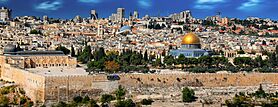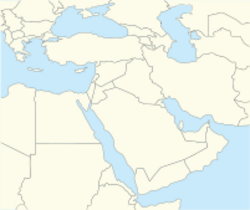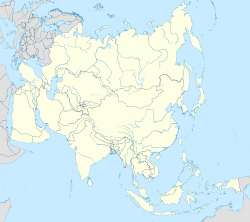Jerusalem facts for kids
Quick facts for kids
Jerusalem
|
|
|---|---|
|
Zion Square
Mamilla Mall
Holy Sepulchre
|
|
Nickname(s):
|
|
| Administered by | Israel |
| Claimed by | Israel and Palestine |
| Israeli district | Jerusalem |
| Palestinian governorate | Quds |
| Gihon Spring settlement | 3000–2800 BCE |
| City of David | c. 1000 BCE |
| Present Old City walls built | 1541 |
| East-West Jerusalem division | 1948 |
| Israeli annexation of East Jerusalem | 1967 |
| Jerusalem Law | 1980 |
| Government | |
| • Type | Mayor–council |
| • Body | Jerusalem Municipality |
| Area | |
| • Metropolis | 125,156 dunams (125.156 km2 or 48.323 sq mi) |
| • Metro | 652,000 dunams (652 km2 or 252 sq mi) |
| Elevation | 754 m (2,474 ft) |
| Population
(2022)
|
|
| • Metropolis | 981,711 |
| • Metro | 1,253,900 |
| Demonyms |
|
| Time zone | UTC+02:00 (IST, PST) |
| • Summer (DST) | UTC+03:00 (IDT, PDT) |
| Postal code |
9XXXXXX
|
| Area code | +972-2 |
| Official name | Old City of Jerusalem and its Walls |
| Type | Cultural |
| Criteria | ii, iii, vi |
| Designated | 1981 |
| Reference no. | 148 |
| Region | Arab States |
| Endangered | 1982–present |
Jerusalem is a very old city located in the Judaean Mountains. It sits between the Mediterranean Sea and the Dead Sea. It is one of the oldest cities in the world where people have lived continuously.
Jerusalem is considered a holy place by three major religions: Judaism, Christianity, and Islam. Both Israel and Palestine claim Jerusalem as their capital city. However, most countries around the world do not officially recognize either claim.
Contents
History of Jerusalem
Jerusalem has a very long and eventful history. It has been attacked many times. The city has been destroyed at least twice and captured 44 times.
Early Settlements
The first signs of people living in Jerusalem date back to about 4000 BCE. This was in the area now called the City of David. Around 1400 BCE, during the time of the Canaanites, the city was called Urusalim. This name likely meant "City of Shalem", after a Canaanite god.
Ancient Kingdoms and Empires
During the time of the Israelites, important building work began around 1000 BCE. By the 9th century BCE, Jerusalem became a major religious and administrative center for the Kingdom of Judah.
According to the Hebrew Bible, King David made Jerusalem the capital of the United Kingdom of Israel. His son, King Solomon, built the First Temple there. These events are very important to the Jewish people.
The Old City Walls
In 1538, the city walls were rebuilt by Suleiman the Magnificent of the Ottoman Empire. These walls still stand today and define the Old City.
Since the 1800s, the Old City has been divided into four main areas: the Armenian, Christian, Jewish, and Muslim quarters. The Old City became a World Heritage Site in 1981.
Modern Growth and Population
Since 1860, Jerusalem has grown much larger than its old city walls. In 2022, Jerusalem had about 971,800 residents. Most of the people living there are Jewish (almost 60%), and a large number are Palestinian (almost 40%).
Religious Importance
Jerusalem is incredibly important to three major world religions.
Jerusalem in Judaism
For Judaism, Jerusalem is a holy city. It is believed to be where King David established his capital. It is also where King Solomon built the First Temple. The Western Wall (also known as the Kotel) is a very important Jewish prayer site. It is part of the retaining wall of the ancient Temple Mount.
Jerusalem in Christianity
For Christianity, Jerusalem is also very holy. The New Testament describes many events involving Jesus in Jerusalem. These include his crucifixion and resurrection. The Church of the Holy Sepulchre is a major Christian site in the city.
Jerusalem in Islam
For Islam, Jerusalem is the third holiest city, after Mecca and Medina. It was the first direction for Muslim prayers. Islamic tradition says that the prophet Muhammad made his Night Journey to Jerusalem in 621 CE. From there, he is believed to have ascended to heaven. The Dome of the Rock and al-Aqsa Mosque are important Islamic sites on the Temple Mount.
Current Status and Government
The status of Jerusalem is a central issue in the Israeli–Palestinian conflict.
Claims and Control
During the 1948 Arab–Israeli War, West Jerusalem became part of Israel. East Jerusalem, which includes the Old City, was controlled by Jordan. In the Six-Day War of 1967, Israel took control of East Jerusalem from Jordan. Israel later passed a law in 1980 called the Jerusalem Law, which states that Jerusalem is Israel's united capital.
Government Institutions
All parts of the Israeli government are located in Jerusalem. This includes the Knesset (Israel's parliament), the homes of the Prime Minister and President, and the Supreme Court.
However, many countries around the world do not agree with Israel's control over East Jerusalem. They see East Jerusalem as Palestinian territory that Israel occupies. Most countries keep their embassies in Tel Aviv instead of Jerusalem.
What Does "Jerusalem" Mean?
The name "Jerusalem" has a very old history.
Meaning of the Name
The name "Jerusalem" likely means "foundation of Shalem." Shalem was a god in the ancient Canaanite religion. His name comes from a root word that means "peace." Because of this, some people think Jerusalem means "The City of Peace" or "Abode of Peace."
The ending of the name, -ayim, suggests "two" in some languages. This might mean that the city was originally built on two hills.
See also
 In Spanish: Jerusalén para niños
In Spanish: Jerusalén para niños













